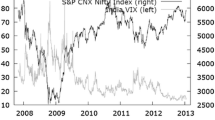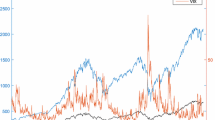Abstract
This study examines the asymmetric relationship between India volatility index (India VIX) and stock market returns, and demonstrates that Nifty returns are negatively related to the changes in India VIX levels, but in case of high upward movements in the market, the returns on the two indices tend to move independently. When the market takes sharp downward turn, the relationship is not as significant for higher quantiles. This property of India VIX makes it a strong candidate for risk management tool whereby derivative products based on the volatility index can be used as a tool for portfolio insurance against worst declines. We also find that India VIX captures stock market volatility better than traditional measures of volatility including ARCH/GARCH class of models. Finally, we test whether changes in India VIX can be used as a signal for switching portfolios. Our analysis of timing strategy based on change in India VIX exhibits that switching to large-cap (mid-cap) portfolio when India VIX increases (decreases) by a certain percentage point can be useful for maintaining positive returns on a portfolio.

Similar content being viewed by others
Notes
The list of volatility indices included in the study is as follows: CBOE volatility index (VIX), Nasdaq volatility index (VXN), DJIA volatility index (VDX), Russel 2000 volatility index (RVX), Deutsche volatility index (VDAX), AEX volatility index (VAEX), BEL 20 volatility index (VBEL), CAC 40 volatility index (VCAC), FTSE 100 volatility index (VFTSE), SWX volatility index (VSMI), Dow Jones EURO STOXX 50 volatility index (VSTOXX), and Montreal exchange volatility index (MVX).
The first criterion, RMSE, measures the differences between the values estimated by a model, say volatility estimated by the GARCHVOL, and the actual values (of realized volatility). Being a scale-dependent measure of accuracy, it compares different estimation errors within a dataset, and serves to aggregate the residuals into a single measure of estimation efficiency. The second one, MAE, is also used to measure how close the implied volatility estimates are to the eventual realized volatility. It is an average of the absolute error of estimation. Finally, mean absolute percent error indicate the estimation accuracy in percentage terms. These criteria are measures of efficiency which are less likely to be affected by the presence of outliers in data set.
Quantile regression is a statistical technique intended to estimate, and conduct inference about, conditional quantile functions. Just as classical linear regression methods based on minimizing sums of squared residuals enable one to estimate models for conditional mean functions, quantile regression methods offer a mechanism for estimating models for the conditional median function, and the full range of other conditional quantile functions. By supplementing the estimation of conditional mean functions with techniques for estimating an entire family of conditional quantile functions, quantile regression is capable of providing a more complete statistical analysis of the stochastic relationships among random variables.
\( {\text{NiftyRet}}_{t}^{ + } \) is NiftyRett if returns on the Nifty index is positive, else 0; and \( {\text{NiftyRet}}_{t}^{ - } \) takes the value of NiftyRet t if returns on the Nifty is negative, else 0.
References
Andersen TG, Bollerslev T (1998) Answering the Skeptics: yes, standard volatility models do provide accurate forecasts. Int Econ Rev 39(4):885–905
Andersen TG, Bollerslev T, Diebold FX, Labys P (2003) Modeling and forecasting realized volatility. Econometrica 71(2):529–626
Andersen TG, Bollerslev T, Christoffersen PF, Diebold FX (2006) Practical volatility and correction modeling for financial markets risk management. In: Carey M, Schultz R (eds) Risk and financial institutions. University of Chicago Press for NBER, Chicago
Arrow Kenneth (1965) Aspects of the theory of risk banking. Yrjö Jahnssonin Säätiö, Helsinki
Bagchi D (2012) Cross-sectional analysis of emerging market volatility index (India VIX) with portfolio returns. Int J Emerg Mark 7(4):383–396
Baker M, Wurgler J (2006) Investor sentiment and the cross-section of stock returns. J Financ 61(4):1645–1680
Banerjee A, Kumar R (2011) Realized volatility and India VIX. WPS No. 688, Indian Institute of Management Calcutta
Basu S (1983) The Relationship between Earnings’ yield, market value, and the return for NYSE common stocks: further evidence. J Financ Econ 12(1):129–156
Becker R, Clements AE, White S (2006) On the informational efficiency of S&P 500 implied volatility. North Am J Econ Financ 17(2):139–153
Becker R, Clements AE, McClelland A (2009) The jump component of S&P 500 volatility and the VIX index. J Bank Financ 33(6):1033–1038
Blair JB, Poon SH, Taylor SJ (2002) Forecasting S&P 100 volatility: the incremental information content of implied volatilities and high frequency index returns. J Econ 105(1):5–26
Brandt M, Kavajecz Kenneth A (2004) Price discovery in the U.S. treasury market: the impact of order flow and liquidity on the yield curve. J Financ 59:2623–2654
Copeland MM, Copeland TE (1999) Market timing: style and size rotation using the VIX. Financ Anal J 55(2):73–81
Corrado CJ, Miller TW (2005) The forecast quality of CBOE implied volatility indexes. J Futures Mark 25(4):339–373
Daniel K, Hirshleifer D, Teoh SH (2002) Investor psychology in capital markets: evidence and policy implications. J Monet Econ 49(1):139–209
Dash S, Moran MT (2005) VIX as a companion for hedge fund portfolios. J Altern Invest 8(3):75–80
De Long JB, Shleifer A, Summers LH, Waldmann RJ (1990) Noise trader risk in financial markets. J Polit Econ 98(4):703–738
Dowling S, Muthuswamy J (2005). The implied volatility of australian index options, accessed from http://www.ssrn.com/abstract=500165. Accessed 17 Oct 2013
Epstein LG, Zin SE (1989) Substitution, risk aversion, and the temporal behavior of consumption and asset returns: a theoretical framework. Econometrica 57(4):937–969
Evans MDD, Lyons RK (2008) How is macro news transmitted to exchange rates? J Financ Econ 88(1):26–50
Fama E (1965) The behavior of stock-market prices. J Bus 38(1):34–105
Fama E, French K (1992) The cross-section of expected stock returns. J Financ 47(2):427–465
Flemming J (1998) The quality of market volatility forecasts implied by S&P 100 index option prices. J Empir Financ 5(4):317–345
Flemming J, Ostdiek B, Whaley R (1995) Predicting stock market volatility: a new measure. J Futures Mark 15(3):265–302
French K (1980) Stock Returns and the Weekend Effect. J Financ Econ 8:55–69
French K, Roll R (1986) Stock return variances: the arrival of information and the reaction of traders. J Financ Econ 17(1):5–26
French K, Schwert GW, Stambaugh R (1987) Expected stock returns and volatility. J Financ Econ 19(1):3–30
Frijns B, Tallau C, Rad-Tourani A (2010) The information content of implied volatility: evidence from Australia. J Futures Mark 30(2):134–155
Giot P (2005a) Implied volatility indexes and daily value-at-risk models. J Deriv 12(4):54–64
Giot P (2005b) Relationships between implied volatility indexes and stock index returns. J Portf Manag 31(3):92–100
Goldstein DG, Taleb NN (2007) We don’t quite know what we are talking about when we talk about volatility. J Portf Manag 33(4):84–86
Guo H, Whitelaw R (2006) Uncovering the risk-neutral relationship in the stock market. J Financ 61(3):1433–1463
Jiang GJ, Lo I (2011) Private information flow and price discovery in the US treasury market. Working paper 2011–5, Bank of Canada
Jiang G, Tian Y (2005) Model-free implied volatility and its information content. Rev Financ Stud 18(4):1305–1342
Kahneman D, Tversky A (1979) Prospect theory: an analysis of decision under risk. Econometrica 47(2):263–292
Koenker R (2005) Quantile regression. Cambridge University Press, London
Koenker R, Bassett GJ (1982) Robust tests for heteroscedasticity based on regression quantile. Econometrica 50(1):43–61
Koenker R, Hallock K (2001) Quantile regression. J Econ Perspect 15(4):143–156
Kumar SSS (2012) A first look at the properties of India’s volatility index. Int J Emerg Mark 7(2):160–176
Kumar MS, Persaud A (2001) Pure contagion and investor shifting risk appetite: analytical issues and empirical evidence. Int Financ 5(3):401–436
Lee CMC, Shleifer A, Thaler R (1991) Investor sentiment and the closed-end fund puzzle. J Financ 46(1):75–109
Lu YC, Wei YC, Chang CW (2012) Nonlinear dynamics between the investor fear gauge and market index in the emerging taiwan equity market. Emerg Mark Financ Trade 48(1):171–191
Maghrebi N, Kim M-S, Nishina K (2007) The KOSPI200 implied volatility index: evidence of regime switches in volatility expectations. Asia-Pacific J Financ Stud 36(2):163–187
McAleer M, Medeiros MC (2008) Realized volatility: a review. Econ Rev 27(1):10–45
Merton R (1980) On estimating the expected return on the market: an exploratory investigation. J Financ Econ 8(4):323–361
Misina M (2003). What does risk-appetite index measure? Bank of Canada Working Paper 2003/23
Neal R, Wheatley SM (1998) Do measures of investor sentiment predict Returns? J Financ Quant Anal 33(4):523–547
NSE (2007) Computation methodology of India VIX, accessed from http://www.nseindia.com/content/vix/India_VIX_comp_meth.pdf. Accessed 3 April 2013
Olsen RA (1998) Behavioral finance and its implications for stock-price volatility. Financ Anal J 54(2):10–18
Pandey A (2005) Volatility models and their performance in Indian capital markets. Vikalpa 30(2):27–46
Poon SH, Granger C (2003) forecasting financial market volatility: a review. J Econ Lit 41(2):478–539
Pratt John (1964) Risk aversion in the small and in the large. Econometrica 32(1/2):122–136
Ross M (1989) Relation of implicit theories to the construction of personal histories. Psychol Rev 96(2):341–357
Sarwar G (2011) The VIX market volatility index and us stock index returns. J Int Bus Econ 11(4):167–179
Sarwar G (2012) Is VIX an investor fear gauge in BRIC equity markets? J Multinatl Financ Manag 22(3):55–65
Sharma JL, Mouugoue M, Kamath R (1996) Heteroscedasticity in stock market indicator return data: volume versus GARCH effect. Appl Financ Econ 6(4):337–342
Shefrin H (2007) Beyond greed and fear. Oxford University Press, New York
Shiller R (1998) Human behavior and the efficiency of the financial system,” NBER Working Paper No. 6375
Simon DP (2003) The nasdaq volatility index during and after the bubble. J Deriv 11(2):9–24
Siriopoulos C, Fassas A (2012) An investor sentiment barometer: greek volatility index (GRIV). Glob Financ J 23(2):77–93
Skiadopoulos G (2004) The greek implied volatility index: construction and properties. Appl Financ Econ 14(16):1187–1196
Szado E (2009) VIX futures and options: a case study of portfolio diversification during the 2008 financial crisis. J Altern Invest 12(2):68–85
Tarashev N, Tsatsaronis K, Karampatos D (2003) Investors’ attitude towards risk: what can we learn from options? BIS Quart Rev 6:57–66
Ting C (2007) Fear in the Korea stock market. Rev Futures Mark 16(1):106–140
Whaley RE (1993) Derivatives on market volatility: hedging tools long overdue. J Deriv 1(1):71–84
Whaley RE (2000) The investor fear gauge. J Portf Manag 26(3):12–17
Whaley RE (2009) Understanding the VIX. J Portf Manag 35(3):98–105
Acknowledgment
The paper is based on a project initiated and sponsored by the National Stock Exchange of India Ltd. (NSE), and the full report has appeared as the NSE Working Paper WP/9/2013 under NSE Working Paper Series. The financial support from the NSE is gratefully acknowledged. We would like to thank Saumitra Bhaduri, P. Krishna Prasanna, Murugappa Murgie Krishnan, and Narend S. for their constructive comments on earlier versions of the paper. We also thank the Editor and anonymous reviewers for their helpful comments. The usual disclaimers apply.
Author information
Authors and Affiliations
Corresponding author
Rights and permissions
About this article
Cite this article
Chandra, A., Thenmozhi, M. On asymmetric relationship of India volatility index (India VIX) with stock market return and risk management. Decision 42, 33–55 (2015). https://doi.org/10.1007/s40622-014-0070-0
Published:
Issue Date:
DOI: https://doi.org/10.1007/s40622-014-0070-0




